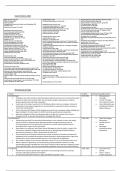Summary
Summary India, c1914-48: The road to Independence Timelines
- Institution
- PEARSON (PEARSON)
A complete Timeline of all key events, as well as an in-depth chronological analysis of each Viceroy of India required for the course: India, c1914-48; The road to Independence. The set of essay plans contain A* level material, drawing on my Indian Independence Complete Course PDF document that is ...
[Show more]



